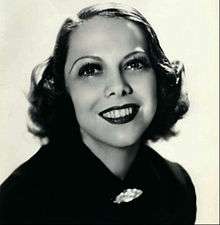Ireene Wicker
Ireene Wicker (born Irene Seaton, November 24, 1905 – November 17, 1987) was an American singer and actress, best known to young radio listeners in the 1930s and 1940s as “The Singing Lady”, which was the title of her radio program.[1]:305 She added the second 'e' in her first name on the advice of an astrologer.[2]
Ireene Wicker | |
|---|---|
 Wicker in 1937. | |
| Born | Irene Seaton November 24, 1905 Quincy, Illinois, U.S. |
| Died | November 17, 1987 (aged 81) West Palm Beach, Florida, U.S. |
| Nationality | American |
| Occupation | Singer, actress |
| Spouse(s) | |
Early years
Wicker was born in Quincy, Illinois. After studying music and drama at the University of Illinois, she studied at the Goodman School of the Theater in Chicago
Stage
Wicker appeared in professional roles at the Goodman Theatre in 1929 and 1930.[3]
Radio
Early in Wicker's radio career she changed the spelling of her first name to Ireene, adding the extra ‘e’ as she was told by a numerologist that one more letter would bring her great success.[3]
Her radio show was first sponsored by the Kellogg Company, beginning in 1931. Her show was promoted as America’s first radio network program for children.[4] Despite the title of her show, The Singing Lady, most of it involved Wicker telling adaptations of stories for children,[4] ranging from fairy tales by the Brothers Grimm and Hans Christian Andersen through to Rudyard Kipling’s Just So Stories. Also in the 1930s and early 1940s, she portrayed Jane Lee on the serial Judy and Jane on NBC-Blue.[1]:181-182
In the 1940s, Wicker was a regular on Deadline Drama on NBC and the Blue Network.[1]:95 In the 1950s, she told stories on Big Jon and Sparkie on ABC radio.[1]
Television
Wicker came to television at WJZ-TV in 1949 with The Ireene Wicker Show in which she told fairy tales. She also had a program, The Singing Lady, on ABC-TV (1948-1950).[5][6]
In 1950 Wicker was one of several broadcasters whose name was included in the book Red Channels, used by many organizations to blacklist anyone who was included as a supposed Communist “sympathizer”. The book charged that she had sponsored a re-election committee for Benjamin J. Davis, a Communist councilman in New York. Although Wicker denied she had even heard of the man,[3] her listing within Red Channels was followed – in what she herself described as a "curious coincidence" – by her sponsor, Kellogg, failing to renew her option for the ABC TV Show.[7] The charges by the House Un-American Activities Committee were later withdrawn with apologies.[3] Another claim, that she sided with leftists during the Spanish Civil War turned out to refer to her support of a fund-raising drive for Spanish refugee children.[8]
Wicker returned to the ABC network in 1953-1954 with "Little Lady Story Time," an unusual half-hour series.[9] Here, she told classic fairy tales while a cast of juvenile ballet dancers enacted the storylines. The sponsor was Little Lady toiletries, a line of soaps, powders, and mild cosmetics for young girls. Among the stories produced were "Puss in Boots," "King Midas and the Golden Touch," "Little Red Riding Hood," and "Pinocchio." One episode ("The Green Monkey") of "The Ireene Wicker Show" and 15 kinescopes of "Little Lady Story Time" are housed at the Library of Congress in the J. Fred and Leslie W. MacDonald Collection.
Personal life
Wicker married Walter Charles Wicker, a radio writer, producer and actor: they had a son, Walter Charles Jr.,[3] who during World War II joined one of the Eagle Squadrons that served with the RAF and was killed in action over the English Channel,[10] and a daughter, Nancy.[3]
Her first marriage ended in divorce in 1938. In 1941 she became the second wife of the businessman Victor J. Hammer.
Recognition
On April 19, 1961, Wicker was recipient of a Peabody Award[11]—Personal Award for Children's Programs for her weekly program, The Singing Lady on WNYC radio.[12]
Publication
- Ireene Wicker The Singing Lady's Favorite Stories (Whitman, 1934)
- Ireene Wicker Young Music Makers: Boyhoods of Famous Composers (The Bobbs-Merrill Company, 1961)
Sources
- Philip D. Caine Eagles of the RAF: The World War II Eagle Squadrons (Diane Publishing, 1994)
- Rima Lunin Schultz & Adele Hast, Women building Chicago 1790-1990: a biographical dictionary (Indiana University Press, 2001)
- "The Singing Lady". Scoop - Where the Magic of Collecting Comes Alive!. Retrieved 2009-04-25.
References
- Terrace, Vincent (1999). Radio Programs, 1924-1984: A Catalog of More Than 1800 Shows. McFarland & Company, Inc. p. 38. ISBN 978-0-7864-4513-4.
- Joseph F. Clarke (1977). Pseudonyms. BCA. p. 171.
- Nan Robertson (1987-11-18). "Ireene Wicker Hammer Dies, 86; Storyteller to Millions of Children". The New York Times. Retrieved 2009-05-24.
- "Kellogg's History". The Digital Deli Online. Retrieved 2012-09-11.
- Terrace, Vincent (2011). Encyclopedia of Television Shows, 1925 through 2010 (2nd ed.). Jefferson, N.C.: McFarland & Company, Inc., Publishers. p. 972. ISBN 978-0-7864-6477-7.
- Woolery, George W. (1985). Children's Television: The First Thirty-Five Years, 1946-1981, Part II: Live, Film, and Tape Series. The Scarecrow Press. pp. 456–458. ISBN 0-8108-1651-2.
- "Gypsy, Scott & Wicker In Red Denials". Billboard. 1950-09-23. Retrieved 2012-09-11.
- The Complete Directory to Prime Time Network and Cable TV Shows, 1946-Present. Ballantine Books. 2003. p. 1076. ISBN 0-345-45542-8.
- Schultz & Hast, Women building Chicago 1790-1990: a biographical dictionary: p. 966
- Eagles of the RAF: The World War II Eagle Squadrons by Philip D. Caine, pp.231-2
- "2009 Photographs of the Month: April". American Heritage Center. 2009. Archived from the original on 2010-07-07. Retrieved 2009-04-25.
- "Personal Award: Ireene Wicker for Children's Programs". Peabody. Retrieved 29 March 2016.